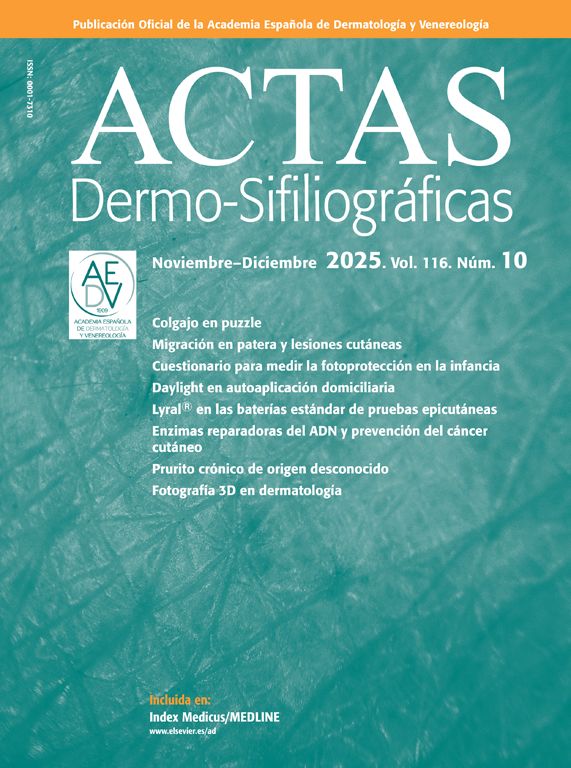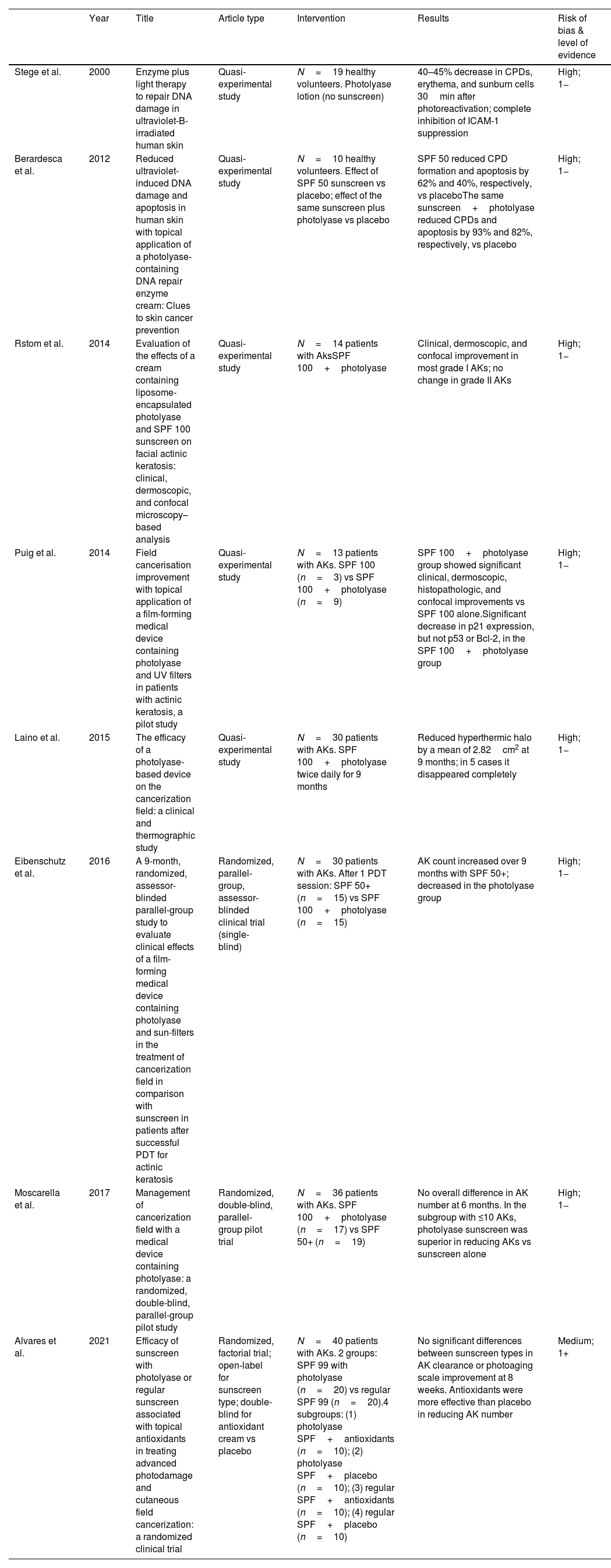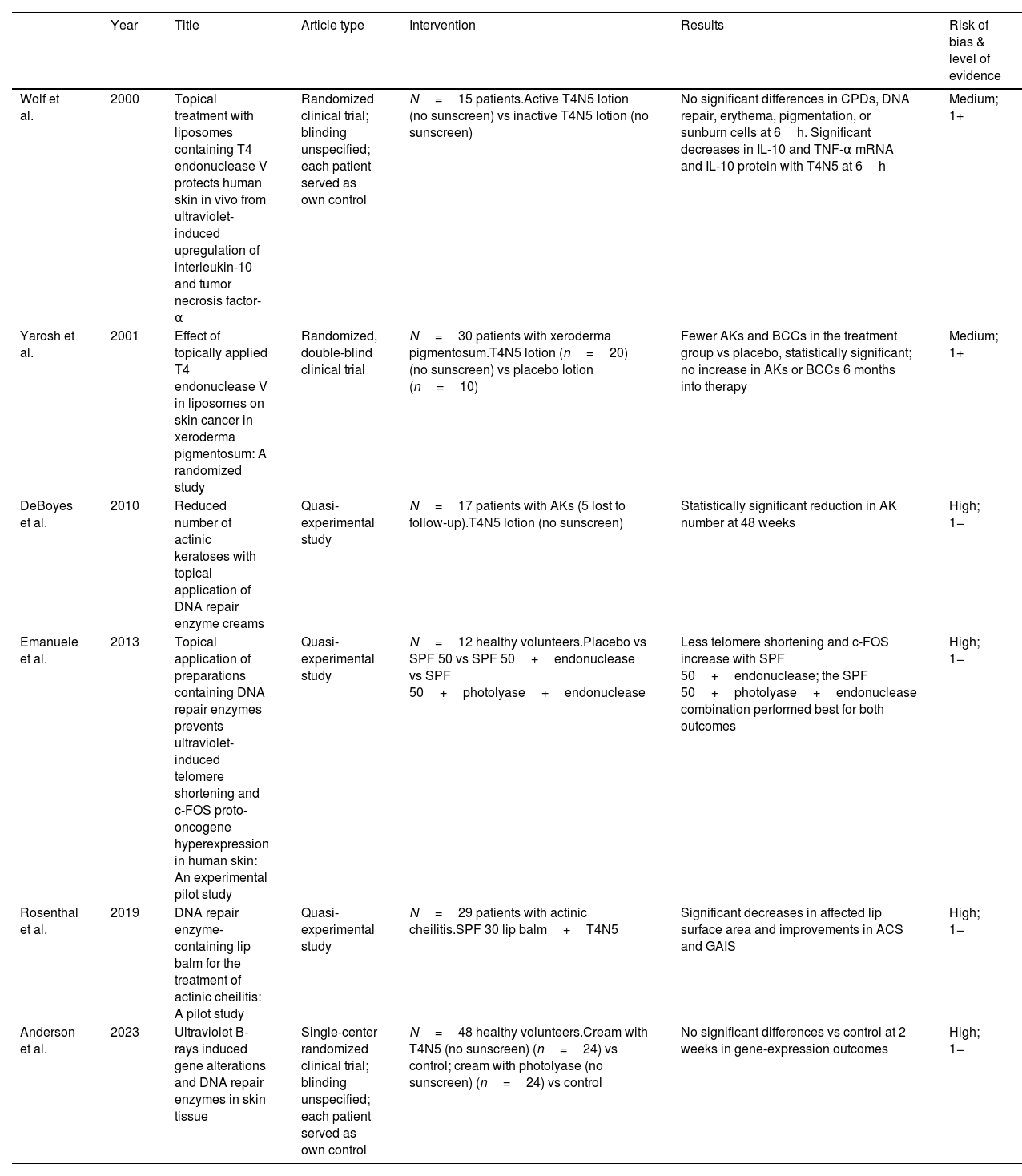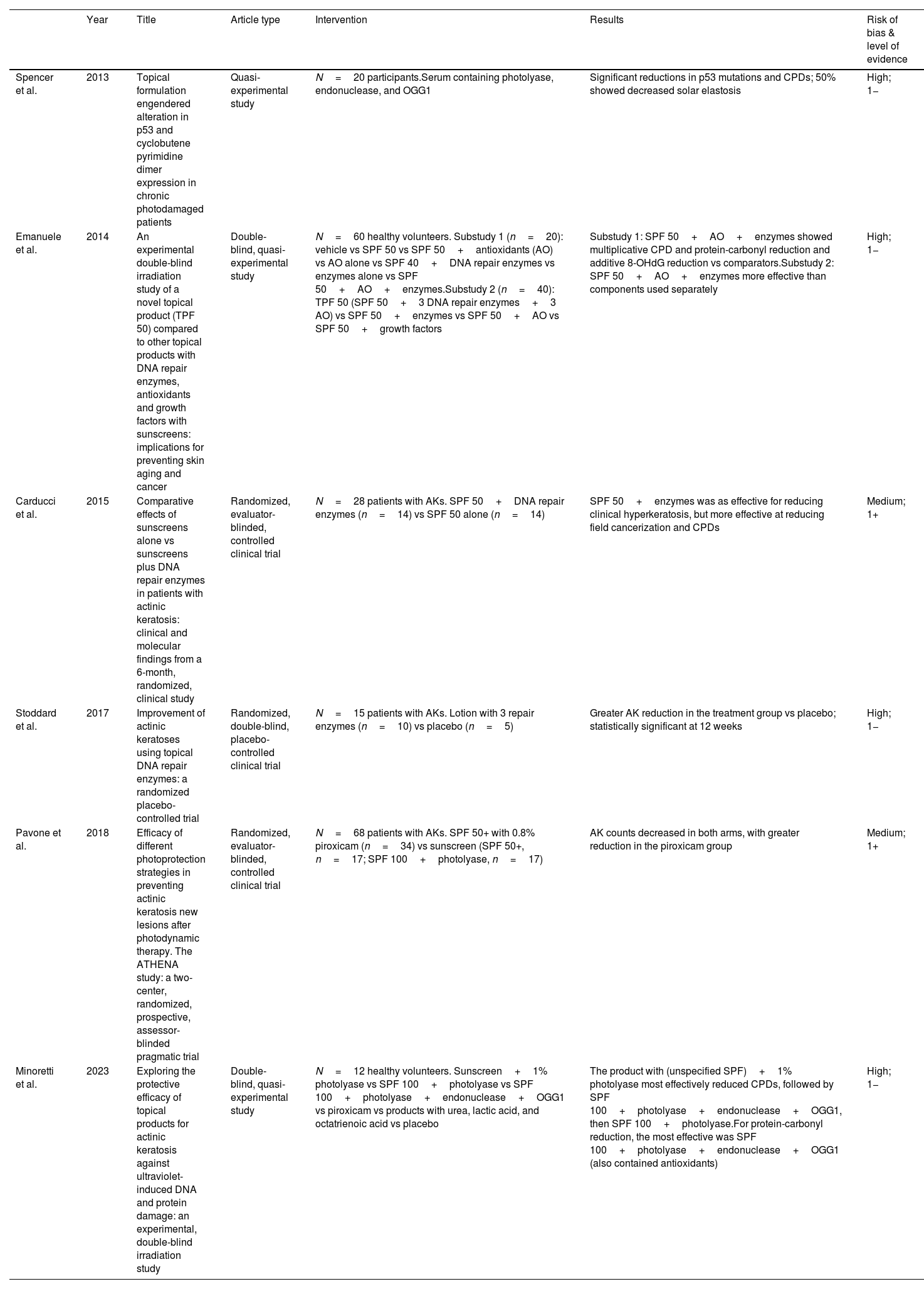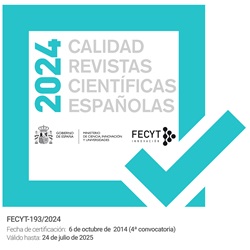The difficulty of traditional photoprotectors in preventing actinic keratoses (AK) and keratinocyte skin cancer has led to research into new photoprotection measures. DNA repair enzymes are compounds that aim to increase the repair of DNA damaged by UV radiation and thus reduce the risk of carcinogenesis.
We conducted a systematic review on the use of DNA repair enzymes in the prevention and treatment of precancerous and cancerous skin conditions in full compliance with the PRISMA guidelines, including stud
ies published from 2000 to 2024.
A total of 486 articles were identified, 20 of which 20 were included: 9 randomized clinical trials and 11 quasi-experimental trials. A total of 8 studies focused on photolyase, 6 on endonuclease, and 6 on combinations of different DNA repair enzymes.
DNA repair enzymes reduce DNA damage and prevent skin cancer, especially when combined with each other as well as with traditional photoprotectors and other substances such as antioxidants. The heterogeneity of the studies limits the ability to draw definitive
conclusions.
La dificultad de los fotoprotectores tradicionales en prevenir las queratosis actínicas (QA) y el cáncer cutáneo queratinocitario han hecho necesaria la búsqueda de nuevas formas de fotoprotección. Las enzimas reparadoras del ADN son compuestos que tienen como objetivo aumentar la reparación del ADN dañado par la radiación UV y reducir así el riesgo de carcinogénesis.
Se realizó una revisión sistemática sobre el uso de enzimas reparadoras de ADN en la prevención y tratamiento del precáncer y cáncer cutáneo de acuerdo con la guía PRISMA, incluyendo estudios publicados entre 2000 y 2024.
Se identificaron 486 artículos, de los cuales se incluyeron 20 estudios: 9 ensayos clínicos aleatorizados y 11 ensayos cuasiexperimentales. Se incluyeron 8 estudios sobre la fotoliasa; 6 estudios sobre la endonucleasa y 6 estudios sobre combinaciones de distintas enzimas reparadoras de ADN.
Las enzimas reparadoras de ADN reducen el daño del ADN y previenen el cáncer de piel, en especial, cuando se combinan entre sí así como con fotoprotectores tradicionales y otras sustancias como los antioxidantes. La heterogeneidad de los estudios limita la posibilidad de establecer conclusiones firmes.
Ultraviolet radiation (UVR) is the principal factor associated with the development of skin cancer and photoaging. It can directly and indirectly damage proteins and nuclear and mitochondrial DNA. Although the body has DNA repair mechanisms, these may be insufficient, so damage accumulates and, over time, leads to skin cancer—primarily as actinic keratoses (AKs) and keratinocyte carcinoma.1
UVR—mainly UVB (290–320nm)—produces direct DNA damage, generating photoproducts such as cyclobutane pyrimidine dimers (CPDs), the most abundant (75%), and 6–4 pyrimidine–pyrimidone photoproducts ((6–4) PPs) (25%).2 These photoproducts are the primary drivers of sunburn, apoptosis, epidermal hyperplasia, and the induction of mutations in tumor suppressor genes such as TP53 or PTCH and in oncogenes such as RAS, ultimately leading to skin cancer.1,3,4
Furthermore, DNA damage promotes an immunosuppressed state, with increases in mediators such as IL-6, IL-10, TNF, and TGF-β that exert immunosuppressive effects facilitating the escape of cancer cells.2
Finally, UVR accelerates telomere shortening1 and can damage repair pathways such as nucleotide excision repair (NER) and base excision repair (BER), which repair CPDs and (6–4) PPs and reactive oxygen species (ROS)-induced damage, respectively.1,3
Another major mechanism by which UVR injures skin is via ROS generation, produced predominantly by UVA (320–400nm).1,2,4 High ROS levels damage DNA and fibroblasts that maintain connective tissue, and they disrupt collagen and elastin. In addition, UVA induces matrix metalloproteinase-1 (MMP-1), which degrades type I collagen.1 8-Hydroxy-2′-deoxyguanosine (8-OHdG) is a key photoproduct arising from ROS–DNA interactions; its detection allows quantification of oxidative damage.1,4
AKs are among the most common UV-induced skin lesions accumulated over years of sun exposure.5 They are a frequent reason for dermatologic consultation, with an estimated prevalence of 28.6% in Spaniards>45 years.5 AKs often arise within a “field cancerization.”6 Individually, AKs carry an annual per-lesion risk of progression to invasive cutaneous squamous cell carcinoma (cSCC) between 0 and 0.075%.6,7 However, cSCC may develop either from a pre-existing AK (0.1–16%) or de novo from a UV-damaged cell within the clinically occult field cancerization, the latter being most common (∼80%).6 Hence, current practice emphasizes “field cancerization treatment.”6 Special sites must not be overlooked, such as the lip, because actinic cheilitis carries a 3–14% risk of progression to invasive cSCC.8–10
To date, traditional sunscreens have shown only moderate protection vs AKs and invasive cSCC and no demonstrated effect against basal cell carcinoma (BCC).3,11
Given the above—and the limitations of traditional sunscreens—there is growing emphasis on “active photoprotection,” which entails sunscreens containing non-filter agents with photoprotective effects such as antioxidants or DNA repair enzymes.1,12 Among the most used DNA repair enzymes are photolyase, endonuclease V (T4V5), and 8-oxoguanine DNA glycosylase (OGG1), with studies focusing mainly on the first two (Fig. 1).
Photolyase is a flavoenzyme present in algae, fish, amphibians, and some non-placental mammals—but not in humans. It recognizes damaged pyrimidine dimers and converts them back to monomers by directly absorbing blue light (300–500nm), a mechanism termed photoreactivation.2,12–15
T4V5, initially isolated from Escherichia coli infected by T4 bacteriophage, augments the human NER pathway by recognizing DNA damage sites, excising them, and resynthesizing new strands with correct base insertion.2,3,14,15
OGG1, present in bacteria, fungi, plants, and mammals, recognizes and initiates repair of ROS-induced damage, reducing 8-OHdG—the oxidative damage marker noted above.2,16 It shows high specificity for mitochondrial DNA, decreases MMP-1 secretion, and prevents collagen loss.16
The objective of this review is to compile and summarize current information on these photoprotective systems for the prevention and treatment of keratinocytic precancer and skin cancer.
Materials and methodsA literature search identified all publications from 2000 to 2024 on topical use of DNA repair enzymes for prevention and treatment of cutaneous precancer and cancer.
Results were limited to human studies published in Spanish or English.
We conducted a comprehensive systematic search across PubMed, The Cochrane Library, Web of Science, and EMBASE/Elsevier in accordance with the Preferred Reporting Items for Systematic Reviews and Meta-Analyses (PRISMA) guideline.17 Keywords used were: DNA repair enzymes, prevention, treatment, and skin cancer.
Eligible articles were classified and analyzed, and references of included articles were reviewed to identify additional studies.
To identify systematic reviews currently underway on DNA repair enzymes for skin-cancer prevention, an electronic search of PROSPERO (the international prospective register of systematic reviews) was also performed.
Search strategy:
- -
(DNA repair enzymes) AND (skin cancer).
- -
(DNA repair enzymes) AND (actinic keratosis) AND (field cancerization).
- -
(Photolyase) AND (skin cancer).
- -
(Endonuclease) AND (skin cancer).
- -
(DNA Repair) AND (oxoguanine glycosylase 1, human) AND (skin neoplasms).
- -
(Ogg1 enzyme) AND (DNA repair) AND (skin cancer).
Inclusion criteria:
- -
Study types: meta-analyses, systematic reviews, and clinical trials.
- -
Population: adults treated topically with DNA repair enzymes regardless of sex, ethnicity, comorbidity, or prior treatment.
- -
Studies had to include patients treated with repair enzymes (photolyase, T4V5, and OGG1) for prevention of skin cancer.
- -
Language restricted to Spanish and English.
Exclusion criteria:
- -
Studies outside the specified time frame.
- -
Studies not using accepted, validated clinical/analytical measures for field cancerization.
- -
Observational studies and case series.
- -
Clinical trials with <10 patients.
- -
Editorials and narrative reviews.
Search results were exported to the Mendeley® reference manager. Title/abstract screening and full-text assessment were performed, and duplicates, exclusions, and inclusions were recorded in a flow diagram (Fig. 2). The search was not restricted by specific authors, journals, or institutions.
Titles and abstracts were screened for inclusion criteria. Full texts of potentially eligible studies were retrieved and critically appraised. Risk of bias for clinical trials was assessed using the Cochrane tool, and levels of evidence were assigned per SIGN criteria.
Risk of bias can occur in article selection for inclusion, data extraction, and data synthesis/analysis.
ResultsWe identified a total of 486 articles in the initial search. After restricting by year (2000–2024, inclusive) and language, 453 remained. Title/abstract screening excluded 428 for not meeting inclusion criteria, leaving 25 articles for review. We then screened the references of these articles to capture studies potentially missed by the database search, finding 4 additional reports that initially met inclusion criteria by title/abstract. Full, critical review of these29 articles led to exclusion of 9:2 were narrative (not systematic) reviews, 1 included only 9 participants, and 6 lacked original studies (available only as meeting abstracts) (Fig. 2). Eventually, a total of 20 studies were included: 8 on photolyase (Table 1), 6 on endonuclease (Table 2), and 6 on combinations of different DNA repair enzymes (Table 3). We found no OGG1 studies meeting our inclusion criteria.
Studies with photolyase.
| Year | Title | Article type | Intervention | Results | Risk of bias & level of evidence | |
|---|---|---|---|---|---|---|
| Stege et al. | 2000 | Enzyme plus light therapy to repair DNA damage in ultraviolet-B-irradiated human skin | Quasi-experimental study | N=19 healthy volunteers. Photolyase lotion (no sunscreen) | 40–45% decrease in CPDs, erythema, and sunburn cells 30min after photoreactivation; complete inhibition of ICAM-1 suppression | High; 1− |
| Berardesca et al. | 2012 | Reduced ultraviolet-induced DNA damage and apoptosis in human skin with topical application of a photolyase-containing DNA repair enzyme cream: Clues to skin cancer prevention | Quasi-experimental study | N=10 healthy volunteers. Effect of SPF 50 sunscreen vs placebo; effect of the same sunscreen plus photolyase vs placebo | SPF 50 reduced CPD formation and apoptosis by 62% and 40%, respectively, vs placeboThe same sunscreen+photolyase reduced CPDs and apoptosis by 93% and 82%, respectively, vs placebo | High; 1− |
| Rstom et al. | 2014 | Evaluation of the effects of a cream containing liposome-encapsulated photolyase and SPF 100 sunscreen on facial actinic keratosis: clinical, dermoscopic, and confocal microscopy–based analysis | Quasi-experimental study | N=14 patients with AksSPF 100+photolyase | Clinical, dermoscopic, and confocal improvement in most grade I AKs; no change in grade II AKs | High; 1− |
| Puig et al. | 2014 | Field cancerisation improvement with topical application of a film-forming medical device containing photolyase and UV filters in patients with actinic keratosis, a pilot study | Quasi-experimental study | N=13 patients with AKs. SPF 100 (n=3) vs SPF 100+photolyase (n=9) | SPF 100+photolyase group showed significant clinical, dermoscopic, histopathologic, and confocal improvements vs SPF 100 alone.Significant decrease in p21 expression, but not p53 or Bcl-2, in the SPF 100+photolyase group | High; 1− |
| Laino et al. | 2015 | The efficacy of a photolyase-based device on the cancerization field: a clinical and thermographic study | Quasi-experimental study | N=30 patients with AKs. SPF 100+photolyase twice daily for 9 months | Reduced hyperthermic halo by a mean of 2.82cm2 at 9 months; in 5 cases it disappeared completely | High; 1− |
| Eibenschutz et al. | 2016 | A 9-month, randomized, assessor-blinded parallel-group study to evaluate clinical effects of a film-forming medical device containing photolyase and sun-filters in the treatment of cancerization field in comparison with sunscreen in patients after successful PDT for actinic keratosis | Randomized, parallel-group, assessor-blinded clinical trial (single-blind) | N=30 patients with AKs. After 1 PDT session: SPF 50+ (n=15) vs SPF 100+photolyase (n=15) | AK count increased over 9 months with SPF 50+; decreased in the photolyase group | High; 1− |
| Moscarella et al. | 2017 | Management of cancerization field with a medical device containing photolyase: a randomized, double-blind, parallel-group pilot study | Randomized, double-blind, parallel-group pilot trial | N=36 patients with AKs. SPF 100+photolyase (n=17) vs SPF 50+ (n=19) | No overall difference in AK number at 6 months. In the subgroup with ≤10 AKs, photolyase sunscreen was superior in reducing AKs vs sunscreen alone | High; 1− |
| Alvares et al. | 2021 | Efficacy of sunscreen with photolyase or regular sunscreen associated with topical antioxidants in treating advanced photodamage and cutaneous field cancerization: a randomized clinical trial | Randomized, factorial trial; open-label for sunscreen type; double-blind for antioxidant cream vs placebo | N=40 patients with AKs. 2 groups: SPF 99 with photolyase (n=20) vs regular SPF 99 (n=20).4 subgroups: (1) photolyase SPF+antioxidants (n=10); (2) photolyase SPF+placebo (n=10); (3) regular SPF+antioxidants (n=10); (4) regular SPF+placebo (n=10) | No significant differences between sunscreen types in AK clearance or photoaging scale improvement at 8 weeks. Antioxidants were more effective than placebo in reducing AK number | Medium; 1+ |
Studies with endonuclease.
| Year | Title | Article type | Intervention | Results | Risk of bias & level of evidence | |
|---|---|---|---|---|---|---|
| Wolf et al. | 2000 | Topical treatment with liposomes containing T4 endonuclease V protects human skin in vivo from ultraviolet-induced upregulation of interleukin-10 and tumor necrosis factor-α | Randomized clinical trial; blinding unspecified; each patient served as own control | N=15 patients.Active T4N5 lotion (no sunscreen) vs inactive T4N5 lotion (no sunscreen) | No significant differences in CPDs, DNA repair, erythema, pigmentation, or sunburn cells at 6h. Significant decreases in IL-10 and TNF-α mRNA and IL-10 protein with T4N5 at 6h | Medium; 1+ |
| Yarosh et al. | 2001 | Effect of topically applied T4 endonuclease V in liposomes on skin cancer in xeroderma pigmentosum: A randomized study | Randomized, double-blind clinical trial | N=30 patients with xeroderma pigmentosum.T4N5 lotion (n=20) (no sunscreen) vs placebo lotion (n=10) | Fewer AKs and BCCs in the treatment group vs placebo, statistically significant; no increase in AKs or BCCs 6 months into therapy | Medium; 1+ |
| DeBoyes et al. | 2010 | Reduced number of actinic keratoses with topical application of DNA repair enzyme creams | Quasi-experimental study | N=17 patients with AKs (5 lost to follow-up).T4N5 lotion (no sunscreen) | Statistically significant reduction in AK number at 48 weeks | High; 1− |
| Emanuele et al. | 2013 | Topical application of preparations containing DNA repair enzymes prevents ultraviolet-induced telomere shortening and c-FOS proto-oncogene hyperexpression in human skin: An experimental pilot study | Quasi-experimental study | N=12 healthy volunteers.Placebo vs SPF 50 vs SPF 50+endonuclease vs SPF 50+photolyase+endonuclease | Less telomere shortening and c-FOS increase with SPF 50+endonuclease; the SPF 50+photolyase+endonuclease combination performed best for both outcomes | High; 1− |
| Rosenthal et al. | 2019 | DNA repair enzyme-containing lip balm for the treatment of actinic cheilitis: A pilot study | Quasi-experimental study | N=29 patients with actinic cheilitis.SPF 30 lip balm+T4N5 | Significant decreases in affected lip surface area and improvements in ACS and GAIS | High; 1− |
| Anderson et al. | 2023 | Ultraviolet B-rays induced gene alterations and DNA repair enzymes in skin tissue | Single-center randomized clinical trial; blinding unspecified; each patient served as own control | N=48 healthy volunteers.Cream with T4N5 (no sunscreen) (n=24) vs control; cream with photolyase (no sunscreen) (n=24) vs control | No significant differences vs control at 2 weeks in gene-expression outcomes | High; 1− |
Studies with combinations of DNA repair enzymes.
| Year | Title | Article type | Intervention | Results | Risk of bias & level of evidence | |
|---|---|---|---|---|---|---|
| Spencer et al. | 2013 | Topical formulation engendered alteration in p53 and cyclobutene pyrimidine dimer expression in chronic photodamaged patients | Quasi-experimental study | N=20 participants.Serum containing photolyase, endonuclease, and OGG1 | Significant reductions in p53 mutations and CPDs; 50% showed decreased solar elastosis | High; 1− |
| Emanuele et al. | 2014 | An experimental double-blind irradiation study of a novel topical product (TPF 50) compared to other topical products with DNA repair enzymes, antioxidants and growth factors with sunscreens: implications for preventing skin aging and cancer | Double-blind, quasi-experimental study | N=60 healthy volunteers. Substudy 1 (n=20): vehicle vs SPF 50 vs SPF 50+antioxidants (AO) vs AO alone vs SPF 40+DNA repair enzymes vs enzymes alone vs SPF 50+AO+enzymes.Substudy 2 (n=40): TPF 50 (SPF 50+3 DNA repair enzymes+3 AO) vs SPF 50+enzymes vs SPF 50+AO vs SPF 50+growth factors | Substudy 1: SPF 50+AO+enzymes showed multiplicative CPD and protein-carbonyl reduction and additive 8-OHdG reduction vs comparators.Substudy 2: SPF 50+AO+enzymes more effective than components used separately | High; 1− |
| Carducci et al. | 2015 | Comparative effects of sunscreens alone vs sunscreens plus DNA repair enzymes in patients with actinic keratosis: clinical and molecular findings from a 6-month, randomized, clinical study | Randomized, evaluator-blinded, controlled clinical trial | N=28 patients with AKs. SPF 50+DNA repair enzymes (n=14) vs SPF 50 alone (n=14) | SPF 50+enzymes was as effective for reducing clinical hyperkeratosis, but more effective at reducing field cancerization and CPDs | Medium; 1+ |
| Stoddard et al. | 2017 | Improvement of actinic keratoses using topical DNA repair enzymes: a randomized placebo-controlled trial | Randomized, double-blind, placebo-controlled clinical trial | N=15 patients with AKs. Lotion with 3 repair enzymes (n=10) vs placebo (n=5) | Greater AK reduction in the treatment group vs placebo; statistically significant at 12 weeks | High; 1− |
| Pavone et al. | 2018 | Efficacy of different photoprotection strategies in preventing actinic keratosis new lesions after photodynamic therapy. The ATHENA study: a two-center, randomized, prospective, assessor-blinded pragmatic trial | Randomized, evaluator-blinded, controlled clinical trial | N=68 patients with AKs. SPF 50+ with 0.8% piroxicam (n=34) vs sunscreen (SPF 50+, n=17; SPF 100+photolyase, n=17) | AK counts decreased in both arms, with greater reduction in the piroxicam group | Medium; 1+ |
| Minoretti et al. | 2023 | Exploring the protective efficacy of topical products for actinic keratosis against ultraviolet-induced DNA and protein damage: an experimental, double-blind irradiation study | Double-blind, quasi-experimental study | N=12 healthy volunteers. Sunscreen+1% photolyase vs SPF 100+photolyase vs SPF 100+photolyase+endonuclease+OGG1 vs piroxicam vs products with urea, lactic acid, and octatrienoic acid vs placebo | The product with (unspecified SPF)+1% photolyase most effectively reduced CPDs, followed by SPF 100+photolyase+endonuclease+OGG1, then SPF 100+photolyase.For protein-carbonyl reduction, the most effective was SPF 100+photolyase+endonuclease+OGG1 (also contained antioxidants) | High; 1− |
Five studies evaluated DNA repair enzymes alone (without added traditional sunscreen), whereas the remaining 15 examined DNA repair enzymes combined with traditional sunscreens, most with SPF 50 or 100.
Of all included studies, 9 were randomized clinical trials18–26 and 11 were quasi-experimental studies.27–37 We accepted quasi-experimental designs because they met our inclusion criteria and were interventional (investigators controlled the intervention), even though they are not methodologically ideal. No systematic review focused specifically on the effect of DNA repair enzymes on skin cancer was found, although we considered one systematic review on DNA repair enzymes and photoaging1 as contextual support, along with several narrative reviews.
Across all studies, the pooled sample comprised 546 participants (ignoring losses): 181 healthy volunteers and 365 patients with AK, field cancerization, a history of keratinocyte carcinoma, or actinic cheilitis. Regarding interventions, 192 used photolyase creams, 151 endonuclease creams, and 203 combinations of different DNA repair enzymes.
With respect to outcomes—considering CPD counts and AK assessments—we observed:
- -
Photolyase: Decreased CPDs in both studies that measured this outcome, by 40%–93%. In 5 of 6 studies assessing AKs, there were clinical, dermoscopic, and histologic improvements; one study found no improvement.
- -
Endonuclease: Did not significantly reduce CPDs vs placebo in the single study that measured CPDs. For AKs, 3 of 4 studies reported reductions with endonuclease use.
- -
Combinations of DNA repair enzymes: Reduced CPDs in all 4 studies that assessed this outcome, by 47–67%. For AKs (assessed in 2 studies), one showed a decrease, while in the other, although improvement was observed, piroxicam cream outperformed the enzyme combination.
Methodologically, most studies had a high risk of bias and a SIGN evidence level of 1−, largely due to study design (nonrandomized, not double-blind, and/or lacking a control group). All quasi-experimental studies were judged high risk of bias because of absent randomization/blinding and, in some cases, no control group. Studies by Wolf et al.,21 Yarrosh et al.,22 Alvares et al.,20 Carducci et al.,24 and Pavone et al.26 were rated medium risk of bias. For Wolf et al., blinding was not explicitly stated, though products were coded “A” and “B” and reportedly identical in composition except for active vs inactive T4V5, implying double-blind conditions. In Yarrosh et al., groups were initially demographically and clinically similar but unevenly sized (20 treatment vs 10 placebo), and 2 placebo patients were lost to follow-up—1 being the oldest (and likely with greater actinic damage). The authors mitigated attrition bias via intention-to-treat analysis; moreover, the loss of the oldest placebo patient would have favored the placebo group, yet results still favored treatment—supporting a medium risk rating and a 1+ evidence level. In the study conducted by Alvares et al., despite sound methods, blinding applied only to the placebo vs antioxidant-cream comparison; there was no direct comparison of conventional sunscreen vs photolyase-containing sunscreen, and follow-up was short. Carducci et al.24 and Pavone et al.26 were considered medium risk because blinding was not specified and appeared to be assessor-blind only.
DiscussionThe continued rise in skin cancer underpins the need to investigate not only new forms of photoprotection but also methods to reverse UVR damage once it has occurred. These realities have spurred studies of multiple substances that, when added to traditional sunscreens, might enhance the capacity to protect and repair skin. Among these, DNA repair enzymes—principally photolyase, endonucleases, and OGG1—stand out.
Photolyase can repair CPDs and 6–4PPs, as demonstrated by Stege et al.,27 who observed a 45% reduction in CPDs after application of a 1% photolyase lotion followed by photoreactivation with a UVA radiation device (340–540nm) for 30min. In Berardesca et al.,28 4 consecutive days of UVR using a solar simulator (Oriel Solar Simulator) at 3 times the MED led to reductions in CPD formation and apoptosis of 93% and 82%, respectively, with an SPF 50 traditional sunscreen plus photolyase vs 62% and 40% for SPF 50 alone and 62% and 40% for placebo, respectively. The higher values in the latter study vs Stege et al. may reflect synergy between traditional sunscreen and photolyase, supporting their combination. Nonetheless, as the Stege group noted, partial CPD repair can yield disproportionate biologic responses—perhaps because certain CPDs are more consequential than others and not all lie within coding regions.
A decrease in CPD production would be expected to translate clinically into improvement of field cancerization and a reduction in AK counts—and this was shown in four studies,18,19,29,30 whereas one found no difference vs traditional sunscreen.20 However, the improvement is most evident in field cancerization and in grade I AKs, as reported by Rstom et al. and Moscarella et al. in their respective studies.19,29 Along these lines, Laino et al.31 evaluated field cancerization after twice-daily application of an SPF 100 traditional sunscreen with photolyase for 9 months. Using active/dynamic thermography—which, unlike classic thermography, applies heat or cold to the target area and measures thermal recovery time—they observed that AKs appeared as hot spots surrounded by a lower-intensity hyperthermic halo extending 2–4cm2, suggestive of the thermographic correlate of field cancerization. Biopsies from these halo areas showed more solar elastosis and higher p53 and Ki-67 expression than non-hyperthermic perilesional skin. After 9 months, mean field area decreased from 3.46cm2 down to 0.64cm2, disappearing entirely in five patients—evidence that photolyase is effective for treating field cancerization.
Accordingly, sunscreens containing photolyase should likely be used as adjuvants to classic AK therapies—cryotherapy, diclofenac, imiquimod, 5-fluorouracil, or photodynamic therapy (PDT)—to prolong therapeutic responses. Eibenschutz et al.18 conducted a randomized clinical trial (30 participants) comparing an SPF 100 traditional sunscreen with photolyase vs an SPF 50+ traditional sunscreen for facial/scalp AKs and field cancerization, applied for 9 months after one PDT session. Mean baseline AK counts were 6.6 in the photolyase group and 8.4 in controls; immediately after PDT, 2.0 and 0.6, respectively. At study end, the photolyase group had a statistically significant reduction (mean 1 AK), whereas controls increased (mean 3–4 AKs), with a significant between-group difference. Moreover, no subjects in the photolyase arm required retreatment during follow-up, whereas 10 of 15 controls required another PDT session.
Pavone et al.26 conducted a clinical trial in 64 AK patients treated with conventional or daylight PDT, then randomized to SPF 50 with 0.8% piroxicam (n=34) vs control (n=34; subdivided to SPF 50 [n=17] or SPF 100 with photolyase [n=17]) twice daily for 6 months. AK reduction was greater with piroxicam (1.8±1.6) than with control (3.2±2.3), a statistically significant difference, leading the authors to suggest that adding a COX-2 inhibitor to a traditional sunscreen is more effective than SPF 100 with photolyase. Notably, however, the authors pooled SPF 50 and SPF 100+ photolyase as a single control, so the latter's effect may have been masked by the lesser efficacy of SPF 50 alone.
As Puig et al.30 suggested, beneficiaries of DNA repair-enzyme sunscreens likely extend beyond patients with AKs—for example, those with xeroderma pigmentosum (XP). Giustini et al.38 (not included in our systematic review due to eligibility criteria) reported that DNA repair enzymes reduced AKs, BCCs, and SCCs in XP patients.
Beyond photoproduct repair, photolyase may also counteract UVR-induced immunosuppression. Stege et al.27 observed complete recovery of intercellular adhesion molecule-1 (ICAM-1), which is involved in inflammation and immunity, suggesting an inhibitory effect on UVR-mediated immunosuppression.
On the other hand, T4 endonuclease V (T4V5), which augments the human NER pathway, was first studied in XP. Yarosh et al.22 followed 30 XP participants for 1 year using a T4V5 lotion (n=20) vs placebo (n=10) and observed statistically significant 68% and 30% reductions in AKs and BCCs, respectively, vs placebo; benefits persisted for 6 months. Thus, deficient NER in XP can be partially complemented by endonuclease therapy.
However, endonuclease also appears useful in individuals with intact NER, and not only cutaneously; it may help actinic cheilitis,32 with reductions in affected area, erythema, scaling, erosion, ulceration, bleeding, and tenderness reported.34 This opens avenues for testing vehicles beyond creams—e.g., balms or lip sunscreens.
Like photolyase, endonuclease may modulate UVR-induced rises in immunosuppressive cytokines; smaller increases in IL-10 and TNF-α have been observed with its use.21
Moreover, UVR can produce genetic changes as early as 24h after exposure, as observed by Anderson et al. in their study, which showed alterations in 8 of the 18 genes analyzed. In that case, applying endonuclease or photolyase for 2 weeks did not prevent these genetic changes, and the authors suggest that longer evaluation periods may be needed to determine the effectiveness of DNA repair enzymes on UVR-induced genetic alterations.
Finally, to enhance efficacy, some studies combine enzymes—sequentially or within a single product—to test for synergy. Emanuele et al.25 reported that sequential use (SPF 50+ with added photolyase before sun exposure, followed by an endonuclease lotion afterward) outperformed either alone, and yielded telomere length and c-FOS levels nearly identical to non-irradiated skin, whereas single-agent results were inferior. Carducci et al.24 randomized 28 AK patients to SPF 50 with endonuclease, photolyase, and OGG1 vs SPF 50 alone, twice daily for 6 months: clinical hyperkeratosis did not differ, but fluorescence after methyl aminolevulinate and CPDs decreased significantly more with the enzyme combination (61% and 35% reductions, respectively). Spencer et al.35 applied a lotion combining photolyase, endonuclease, and OGG1 twice daily for 8 weeks to 20 subjects and observed significant reductions in CPDs and p53. Stoddard et al.25 compared the same triple-enzyme lotion to placebo twice daily for 8 weeks; differences emerged at week 12 (four weeks post-treatment), implying either that longer study windows are needed or that enzyme effects persist after cessation. A major limitation in Spencer and Stoddard is that all participants also received traditional sunscreens (SPF 29 and 100, respectively) for use on the test area with frequency unspecified—potentially confounding results.
Finally, using antioxidants alongside different DNA repair enzymes appears to confer additional benefit. Minoretti et al.37 demonstrated this in a study in which 12 healthy volunteers had seven areas on the lower back treated with different products: a conventional sunscreen (SPF not specified) that also contained 1% photolyase; a conventional sunscreen with SPF 100 plus photolyase (concentration not specified); and a conventional sunscreen with SPF 100 that also contained endonuclease, photolyase, OGG1, and various antioxidant substances, among others. All products were applied for 8 consecutive days, and the sites were irradiated with a UVR device at 6 times the MED. A greater reduction in CPDs was observed with products having higher SPF and higher photolyase concentration, whereas protein carbonylation was lower with those containing antioxidants. Thus, the authors conclude that products should incorporate DNA repair enzymes to repair direct UVB-induced DNA damage and address radiation-induced oxidative protein damage through antioxidants. Emanuele et al.36 reached the same conclusion.
Limitations of this review lie chiefly in the impossibility of relying solely on high-level evidence, given the scarcity of methodologically robust and mutually consistent studies—underscoring the lack of clinical trials on this topic with clear, reliable, and reproducible methods. This diminishes the quality of the review. In addition, the studies included generally had small sample sizes; most lacked randomization and blinding; groups were not always comparable in number of participants or epidemiologic and clinical characteristics; and intervention protocols were variably specified and often heterogeneous with respect to the DNA repair substances used, their combination (or not) with sunscreens of different SPFs, as well as days and method of application. All of this may compromise the validity and generalizability of their results, with alpha and beta risks.
Moreover, regarding the conduct of this work, selection bias is possible because the search strategy was as described; despite meticulous effort, some studies may have been missed along with relevant information. Restricting by year, language, and number of patients may also introduce such bias. Information bias may likewise have occurred during data extraction, analysis, and interpretation.
ConclusionsNumerous studies show that DNA repair enzymes may play a role in preventing keratinocyte skin cancer, as they act mainly on UVR-induced photoproducts in keratinocyte DNA and thereby on skin carcinogenesis.1,2,13,39–41 Their principal therapeutic effect has been demonstrated in non-hyperkeratotic AKs and in field cancerization.19,29,31,40,41 Accordingly, their adjuvant use alongside classic treatments is increasingly discussed to prolong therapeutic responses.25,42 Photolyase seems faster and more effective than endonuclease at repairing CPDs, since it is absent in humans and effectively adds an extra repair system, whereas endonuclease leverages the existing NER pathway.43 On the other hand, although each study followed its own protocol, twice-daily application is most common. The duration needed to achieve clinical benefit cannot be defined, though effects have been observed after as little as one month of use.30 What does seem apparent is that DNA repair enzymes are more useful when combined with conventional sunscreen and, even more so, when combined with multiple DNA repair enzymes plus agents acting at other levels, such as antioxidants.24,33,35–37 However, no clear conclusions can be drawn about whether adding DNA repair enzymes would allow lowering the SPF, or whether significant differences exist between products containing DNA repair enzymes with SPF 50+ versus 100. More randomized, blinded clinical trials with longer follow-up are needed to strengthen these findings.
Finally, there remains substantial room for research and development in DNA repair enzymes. On one hand, molecules that are still little studied—such as OGG1—seem to play a role in both keratinocyte cancer44 and melanoma,45 by counteracting ROS and showing greater selectivity for repairing mitochondrial DNA.46 On the other hand, there is growing interest in the potential role of DNA repair enzymes in after-sun products, given the recent discovery of “dark” cyclobutane pyrimidine dimers produced hours after UVR exposure has ended.47,48 For all these reasons, further publications and applications of DNA repair enzymes can be anticipated.
Conflicts of interestNone declared.
